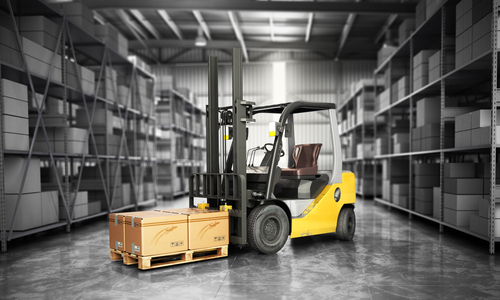Forklift load centre distances
In forklift operation, understanding load centre distances is crucial for ensuring both safe and efficient handling of loads. These distances refer to specific measurements that affect the forklift’s stability and capacity to lift safely.
Horizontal load centre distance
This is the horizontal distance from the face of the forks (or from the heel where the forks are attached to the mast) to the centre of gravity of the load being carried. This measurement is essential because it helps determine the lifting capacity of the forklift. A load with a greater horizontal load centre increases the moment (rotational force) on the forklift, which can lead to instability. If the load centre distance exceeds the rated capacity for that specific forklift, there is an increased risk of tipping, especially when turning or lifting the load to significant heights.
Vertical Load Centre Distance
The vertical load centre is measured from the top of the forks to the centre of gravity of the load, determining how high a load can be safely lifted. This vertical distance impacts the forklift’s ability to maintain stability as the load height increases. Higher loads shift the centre of gravity upwards, making the forklift top-heavier and more susceptible to tipping, particularly when navigating inclines or during sharp turns. Proper vertical load centre management ensures the forklift can safely lift the load without compromising balance.
Why These Distances Are Important
Both horizontal and vertical load centre distances directly affect the forklift’s stability and capacity. If either distance exceeds the manufacturer’s specifications, the forklift may become unstable, leading to potential tipping hazards. Forklift operators must always be aware of these distances, ensuring that loads are balanced correctly within the recommended limits to maintain safety during operations. Misjudging load centre distances can result in accidents, equipment damage, or injury, highlighting the critical role of understanding these measurements in safe forklift operation.
The vertical load centre distance isn’t commonly referred to in forklift operations for a few key reasons, primarily due to the way forklift stability and load capacity are generally evaluated.
Focus on horizontal load centre distance
The primary factor in forklift safety and capacity is the horizontal load centre, which is directly linked to the forklift’s lifting ability and stability. Manufacturers typically rate forklifts based on horizontal load centres, because this dimension directly impacts the machine’s ability to handle loads safely. Most forklifts are designed to operate with loads centre distance horizontally, and capacity charts often provide load limits based on specific horizontal load centre distances (e.g., 600mm). Therefore, operators and safety guidelines emphasize this measure as it’s more straightforward in determining safe lifting limits.
Vertical load centre distance
The vertical load centre has a less obvious and less frequently discussed impact on stability. While it’s important, its effect on tipping is usually secondary to the horizontal load centre. The vertical load centre influences how high a load can be lifted without becoming top-heavy. However, the tipping risks associated with vertical load centres are often mitigated in the design of the forklift and in the typical lifting height range for which it is used. Operators tend to focus on the horizontal load centre because it’s easier to monitor and more directly related to lifting performance.
Load distribution is typically horizontal
Loads are usually distributed more noticeably along the horizontal axis, making the horizontal load centre the more critical factor for evaluating forklift capacity. Vertical load centres only come into play when loads are particularly tall or off-centre, which is less common in many standard forklift operations.
In summary
In essence, while the vertical load centre is an important consideration, its role is typically understood in the context of load height and balance. It’s less frequently discussed because the more critical and immediate factor for forklift operators is the horizontal load centre, which directly impacts both stability and lifting capacity.
Onsite Forklift Licencing provides industry with a convenient and comprehensive on site training program for small groups in Western Australia.
Check out our courses here https://onsiteforkliftlicencing.com/or call now to find out about course availability at you site.
Gil Deane
